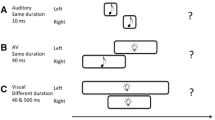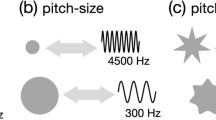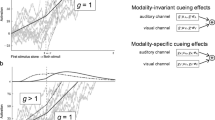Abstract
In two experiments, we examined the extent to which audiovisual temporal order judgments (TOJs) were affected by spatial factors and by the dimension along which TOJs were made. Pairs of auditory and visual stimuli were presented from either the left and/or right of fixation at varying stimulus onset asynchronies (SOAs), and participants made unspeeded TOJs regarding either "Which modality was presented first?" (experiment 1), or "Which side was presented first?" (experiment 2). Modality TOJs were more accurate (i.e. just-noticeable differences, JNDs, were smaller) when the auditory and visual stimuli were presented from different spatial positions rather than from the same position, highlighting an important potential confound inherent in previous research. By contrast, spatial TOJs were unaffected by whether or not the two stimuli were presented in different modalities. A between-experiments comparison revealed more accurate performance (i.e. smaller JNDs) when people reported which modality came first than when they reported which side came first for identical bimodal stimulus pairs. These results demonstrate that multisensory TOJs are critically dependent on both the relative spatial position from which stimuli are presented and on the particular dimension being judged.





Similar content being viewed by others
Notes
In the Introduction to their paper, Hirsh and Sherrick (1961) point out that performance on simultaneous/successive judgment tasks will be affected by the dimension along which stimuli vary, despite the fact that they do not consider this point for the TOJ studies they report. However, this apparent inconsistency may simply reflect another of Hirsh and Sherrick's underlying assumptions, namely, that TOJs and simultaneous/successive judgment tasks rely on very different neural mechanisms.
The +200 ms points were excluded from this computation, because most participants performed nearly perfectly at this interval, so no additional variance was accounted for by these points. The inclusion of these points would actually have resulted in an artefactual reduction in slope.
This hemispheric redundancy account can be considered as a specific example of a more general "spatial channel" account (see Regan 1982 for a review). That is, stimuli presented from the same spatial location may activate a common limited capacity spatial channel, whereas stimuli presented to different spatial positions may activate different spatial channels. However, we prefer the hemispheric redundancy account over the spatial channel account given the problems that are associated with the appropriate definition of a channel (see Regan 1982; Spence et al. 2001b).
Because light travels through air far more rapidly than sound, these differences in transduction latencies can be offset, or even reversed, for pairs of audiovisual stimuli that occur very far from us (see Pöppel et al. 1990). For example, we often see distant lightening before hearing the associated thunder (Spence and Squire 2003). However, such differences are unlikely to have had any significant effect in the present studies since the auditory and visual stimuli were presented relatively close to the participants (distance=62 cm; see also Sugita and Suzuki 2003).
References
Allan LG (1975) The relationship between judgments of successiveness and judgments of order. Percept Psychophys 18:29–36
Bald L, Berrien FK, Price JB, Sprague RO (1942) Errors in perceiving the temporal order of auditory and visual stimuli. J Appl Psychol 26:382–388
Banich MT (1998) The missing link: the role of interhemispheric interaction in attentional processing. Brain Cogn 36:128–157
Bergenheim M, Johansson H, Granlund B, Pedersen J (1996) Experimental evidence for a sensory synchronization of sensory information to conscious experience. In: Hameroff SR, Kaszniak AW, Scott AC (eds) Toward a science of consciousness: the first Tucson discussions and debates. MIT Press, London, UK, pp 303–310
Bertelson P (1998) Starting from the ventriloquist: the perception of multimodal events. In: Sabourin M, Craik FIM, Robert M (eds) Biological and cognitive aspects. (Advances in psychological science, Vol 2) Psychological, Hove, UK, pp 419–439
Bertelson P, Gelder B de (2003) The psychology of multimodal perception. In: Spence C, Driver J (eds) Crossmodal space and crossmodal attention. Oxford University Press, Oxford, UK
Bushara KO, Grafman J, Hallett M (2001) Neural correlates of auditory-visual stimulus onset asynchrony detection. J Neurosci 21:300–304
Calvert GA, Brammer MJ, Iversen SD (1998) Crossmodal identification. Trends Cognit Sci 2:247–253
Dinnerstein AJ, Zlotogura P (1968) Intermodal perception of temporal order and motor skills: effects of age. Percept Mot Skill 26:987–1000
Drew F (1896) Attention: experimental and critical. Am J Psychol 7:533–573
Driver J, Spence C (1998) Crossmodal links in spatial attention. Philos Trans R Soc B 353:1319–1331
Driver J, Spence C (2000) Multisensory perception: beyond modularity and convergence. Curr Biol 10:731–735
Exner S (1875) Experimentelle Untersuchung der einfachsten psychischen Processe (Experimental study of the most simple psychological processes). Pflugers Arch 11:403–432
Fendrich R, Corballis PM (2001) The temporal cross-capture of audition and vision. Percept Psychophys 63:719–725
Finger R, Davis AW (2001) Measuring video quality in videoconferencing systems. Technical Report SN187-D. Pixel Instrument Corporation, Los Gatos, CA
Finney DJ (1964) Probit analysis: statistical treatment of the sigmoid response curve. Cambridge University Press, London, UK
Friedman A, Polson MC (1981) Hemispheres as independent resource systems: limited-capacity processing and cerebral specialization. J Exp Psychol Hum Percept Perform 7:1031–1058
Gebhardt JW, Mowbray GH (1959) On discriminating the rate of visual flicker and auditory flutter. Am J Psychol 72:521–528
Gengel RW, Hirsh IJ (1970) Temporal order: the effect of single versus repeated presentations, practice, and verbal feedback. Percept Psychophys 7:209–211
Grossberg S, Grunewald A (1997) Cortical synchronization and perceptual framing. J Cognit Neurosci 9:117–132
Hamlin AJ (1895) On the least observable interval between stimuli addressed to disparate senses and to different organs of the same sense. Am J Psychol 6:564–575
Herdman CM, Friedman A (1985) Multiple resources in divided attention: a cross modal test of independence of hemispheric resources. J Exp Psychol Hum Percept Perform 11:40–49
Hirsh IJ (1959) Auditory perception of temporal order. J Acoust Soc Am 31:759–767
Hirsh IJ, Sherrick CE Jr (1961) Perceived order in different sense modalities. J Exp Psychol 62:423–432
ITU-T (1990) Television and sound transmission: tolerances for transmission time differences between the vision and sound components of a television signal. Telecommunication standardization sector of ITU, Recommendation J100, CMTT 717 in CCIR Recommendations 12. International Telecommunication Union, Düsseldorf, Germany
Jaskowski P, Jaroszyk F, Hojan-Jerierska D (1990) Temporal-order judgments and reaction time for stimuli of different modalities. Psychol Res 52:35–38
Kahneman D, Treisman A, Gibbs BJ (1992) The reviewing of object files: object-specific integration of information. Cognit Psychol 24:175–219
King AJ, Palmer AR (1985) Integration of visual and auditory information in bimodal neurones in the guinea-pig superior colliculus. Exp Brain Res 60:492–500
Kinsbourne M, Cook J (1971) Generalized and lateralized effects of concurrent verbalization on a unimanual skill. Q J Exp Psychol 23:341–345
Kinsbourne M, Hicks RE (1978) Functional cerebral space: a model for overflow, transfer and interference effects in human performance: a tutorial review. In: Requin J (ed) Attention and performance, VII. Erlbaum, Hillsdale, NJ, pp 345–362
Kristofferson AB (1967) Attention and psychophysical time. Acta Psychol 27:93–100
Lewald J, Ehrenstein WH, Guski R (2001) Spatio-temporal constraints for auditory-visual integration. Behav Brain Res 121:69–79
McFarland DJ, Cacace AT, Setzen G (1998) Temporal-order discrimination for selected auditory and visual stimulus dimensions. J Speech, Lang Hearing Res 41:300–314
McGrath M, Summerfield Q (1985) Intermodal timing relations and audio-visual speech recognition by normal-hearing adults. J Acoust Soc Am 77:678–685
Meredith MA, Stein BE (1983) Interactions among converging sensory inputs in the superior colliculus. Science 221:389–391
Mitrani L, Shekerdjiski S, Yakimoff N (1986) Mechanisms and asymmetries in visual perception of simultaneity and temporal order. Biol Cybern 54:159–165
Morein-Zamir S, Soto-Faraco S, Kingstone AF (2003) Auditory capture of vision: examining temporal ventriloquism. Cogn Brain Res 17:154–163
Mortlock AN, Machin D, McConnell S, Sheppard P (1997) Virtual conferencing. BT Technol J 15:120–129
Moutoussis K, Zeki S (1997) A direct demonstration of perceptual asynchrony in vision. Proc R Soc Lond B Biol 264:393–399
Neumann O, Niepel M (2003) Timing of "perception" and perception of "time". In: Kaernbach C, Schröger E, Müller H (eds) Psychophysics beyond sensation: laws and invariants of human cognition. (Scientific Psychology Series) Erlbaum, Hove, UK
Pandev PC, Kunov H, Abel SM (1986) Disruptive effects of auditory signal delay on speech perception with lip-reading. J Aud Res 26:27–41
Pöppel E, Schill K, Steinbüchel N von (1990) Sensory integration within temporally neutral system states: a hypothesis. Naturwissenschaften 77:89–91
Posner MI, Nissen MJ, Klein RM (1976) Visual dominance: an information-processing account of its origins and significance. Psychol Rev 83:157–171
Rains JD (1963) Signal luminance and position effects in human reaction time. Vision Res 3:239–251
Raizada RDS, Poldrack RA (2001) Event-related fMRI of audio-visual simultaneity perception. Soc Neurosci Abstr 27:511.14
Rao SM, Mayer AR Harrington DL (2001) The evolution of brain activation during temporal processing. Nat Neurosci 4:317–323
Reeves B, Voelker D (1993) Effects of audio-video asynchrony on viewer's memory, evaluation of content and detection ability. Research report. Pixel Instruments, Los Gatos, CA
Regan D (1982) Visual information channeling in normal and disordered vision. Psychol Rev 89:407–444
Regan D, Spekreijse H (1977) Auditory-visual interactions and the correspondence between perceived auditory space and perceived visual space. Perception 6:133–138
Rihs S (1995) The influence of audio on perceived picture quality and subjective audio-visual delay tolerance. In: Hamberg R, Ridder H de (eds) Report 1071. Proc MOSAIC workshop, Eindhoven, 18–19 Sept: Advanced methods for the evaluation of television picture quality. Inst Percept Res, pp 133–137
Roberson GE, Hairston WD, Wallace MT, Stein BE, Laurienti PJ, Schirillo JA (2001) Unifying multisensory signals across time and space. Soc Neurosci Abstr 27:511.19
Rutschmann J, Link R (1964) Perception of temporal order of stimuli differing in sense mode and simple reaction time. Percept Mot Skills 18:345–352
Sade A, Spitzer H (1998) The effects of attentional spread and attentional effort on orientation discrimination. Spatial Vision 11:367–383
Scheier CR, Nijhawan R, Shimojo S (1999) Sound alters visual temporal resolution. Invest Ophthalmol Vis Sci 40:S792
Shore DI, Spence C, Klein RM (2001) Visual prior entry. Psychol Sci 12:205–212
Shore DI, Spry E, Spence C (2002) Confusing the mind by crossing the hands. Cogn Brain Res 14:153–163
Slutsky DA, Recanzone GH (2001) Temporal and spatial dependency of the ventriloquism effect. Neuroreport 12:7–10
Smith WF (1933) The relative quickness of visual and auditory perception. J Exp Psychol 16:239–257
Spence C (2001) Crossmodal attentional capture: a controversy resolved? In: Folk C, Gibson B (eds) Attention, distraction and action: multiple perspectives on attentional capture. Elsevier Science, Amsterdam, pp 231–262
Spence C, Driver J (1999) A new approach to the design of multimodal warning signals. In: Harris D (ed) Job design, product design and human-computer interaction. (Engineering psychology and cognitive ergonomics, Vol 4) Ashgate: Hampshire, pp 455-461
Spence C, Squire SB (2003) Multisensory integration: maintaining the perception of synchrony. Curr Biol 13:R519–R521
Spence C, Nicholls MER, Driver J (2001a) The cost of expecting events in the wrong sensory modality. Percept Psychophys 63:330–336
Spence C, Shore DI, Klein RM (2001b) Multisensory prior entry. J Exp Psychol Gen 130:799–832
Spence C, Baddeley R, Zampini M, James R, Shore DI (2003) Crossmodal temporal order judgments: when two locations are better than one. Percept Psychophys
Stein BE, Meredith MA (1993) The merging of the senses. MIT Press, Cambridge, MA
Sternberg S, Knoll RL, Gates BA (1971) Prior entry reexamined: effect of attentional bias on order perception. Presented, meeting Psychon Soc, November, St. Louis, MO
Stone JV, Hunkin NM, Porrill J, Wood R, Keeler V, Beanland M, Port M, Porter NR (2001) When is now? Perception of simultaneity. Proc R Soc B 268:31–38
Stone SA (1926) Prior entry in the auditory-tactual complication. Am J Psychol 37:284–287
Sugita Y, Suzuki Y (2003) Implicit estimation of sound-arrival time. Nature 421:911
Teatini G, Farnè M, Verzella F, Berruecos P Jr (1976) Perception of temporal order: visual and auditory stimuli. G Ital Psicol 3:157–164
Ulrich R (1987) Threshold models of temporal-order judgments evaluated by a ternary response task. Percept Psychophys 42:224–239
Urbach D, Spitzer H (1995) Attentional effort modulated by task difficulty. Vision Res 35:2169–2177
Van de Par S, Juola JF, Kohlrausch A (1999) Judged synchrony/asynchrony for light-tone pairs. Presented 40th Ann meeting Psychon Soc, Los Angeles, CA
Welch RB, DuttonHurt LD, Warren DH (1986) Contributions of audition and vision to temporal rate perception. Percept Psychophys 39:294–300
Whipple GM, Sanford EC, Colgrove FW (1899) Minor studies from the psychological laboratory of Clark University: on nearly simultaneous clicks and flashes: the time required for recognition: notes on mental standards of length. Am J Psychol 10:280–295
Zampini M, Shore DI, Spence C (2003) Multisensory temporal order judgments: the role of hemispheric redundancy. Int J Psychophysiol (in press)
Acknowledgements
Charles Spence and David I. Shore were funded by a Network Grant from the McDonnell-Pew Centre for Cognitive Neuroscience, University of Oxford. David I. Shore was also funded by an operating grant from the Natural Science and Engineering Research Council of Canada.
Author information
Authors and Affiliations
Corresponding author
Rights and permissions
About this article
Cite this article
Zampini, M., Shore, D.I. & Spence, C. Audiovisual temporal order judgments. Exp Brain Res 152, 198–210 (2003). https://doi.org/10.1007/s00221-003-1536-z
Received:
Accepted:
Published:
Issue Date:
DOI: https://doi.org/10.1007/s00221-003-1536-z




